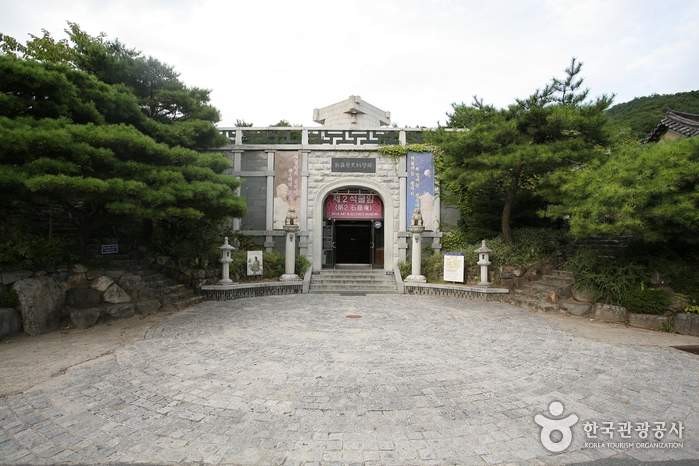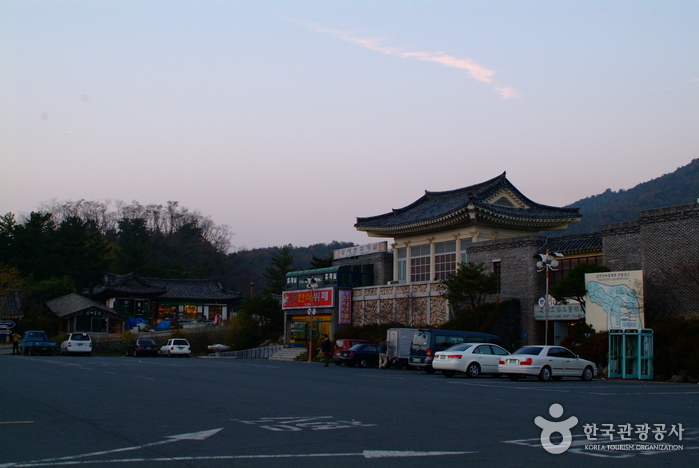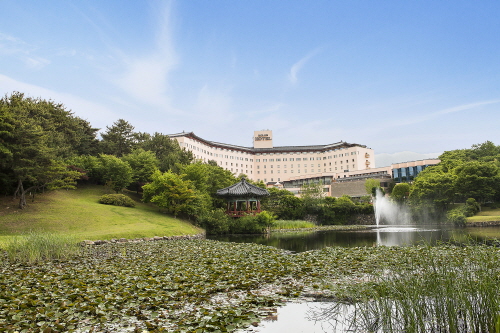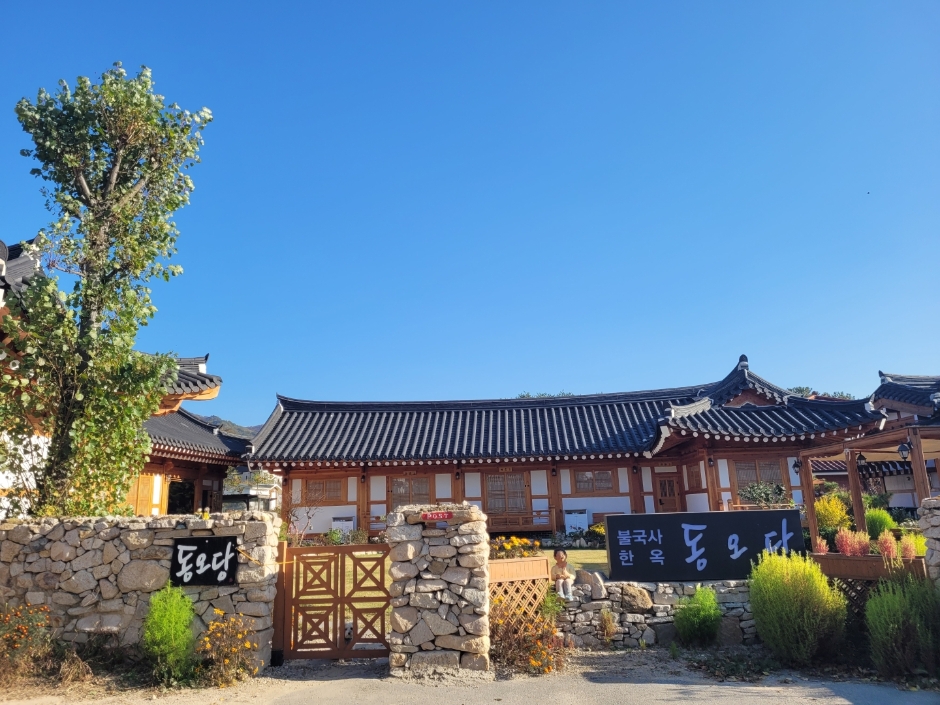Surime (Instituto de Experimentación de Comida Tradicional de Corea) (수리뫼 [한국전통음식체험교육원])
8.7Km 16626 2021-01-22
Poseok-ro 110-26, Naenam-myeon, Gyeongju-si, Gyeongsangbuk-do
+82-54-748-2507
El monte Namsan, situado en la zona sur de la ciudad de Gyeongju, está registrado en la Unesco conlas denominaciones de Gouisan por su pico más alto, Cheollyongsan y también Surimoe en coreano puro.
El Instituto de Experimentación de Comida Tradicional de Corea, Surime, es dirigido por Park Mi-suk, quien estudió bajo Hwang Hye-seong, propietario del Bien Cultural Intangible Nº 38 por la cocina de la realeza de la dinastía Joseon. El instituto ofrece varios cursos de cocina tradicional.
Surime (수리뫼)
8.7Km 10129 2019-11-21
110-32, Poseok-ro, Gyeongju-si, Gyeongsangbuk-do
+82-54-748-2507
Surime is surrounded by Gyeongju Namsan Mountain, a designated UNESCO World Cultural Heritage Site. Surime serves royal cuisine from the Joseon dynasty, prepared by royal cuisine expert Park Misuk. All dishes are prepared with fresh ingredients grown in the Surime garden for a pure, natural taste. In addition to being a restaurant, guests can also participate in various food programs.
Museo de Arte y Ciencia de Silla (신라역사과학관)
8.8Km 31349 2023-04-07
Hadonggongyechon-gil 33, Gyeongju-si, Gyeongsangbuk-do
+82-54-745-4998
El Museo de Arte y Ciencia de Silla se encuentra en la Aldea de Artesanía Popular de Gyeongju y muestra modelos en miniatura de bienes culturales en la región para promover los principios científicos de sus propiedades culturales.
En el primer piso del museo hay artículos culturales como Sillawanggyeongdo, reliquias desenterradas de la tumba de Hwangnamdaechong y una reconstrucción de las del monte Namsan. El segundo piso alberga una corona de oro de Silla y Baekje, y la Tripitaka Koreana del templo de Haeinsa. El subsuelo tiene miniaturas de la gruta Seokguram y Gunwisamjonseokbul en el monte Palgongsan. Fuera del museo, se exhiben el solar del templo Gameunsa y el observatorio Cheomseongdae.
El museo es único por presentar métodos de preservación científica de reliquias culturales basadas en un análisis exhaustivo de su estructura y belleza genuinas.
Aldea de Artesanías Tradicionales de Gyeongju (경주민속공예촌)
8.9Km 23010 2021-06-17
Bobul-ro 230, Gyeongju-si, Gyeongsangbuk-do
+82-54-746-7270
En la ruta turística cerca de la base del monte Tohamsan, entre el templo Bulguksa y el complejo turístico del lago Bomun, se sitúan nada menos que 45 casas tradicionales con techos de teja y paja. La Aldea de Artesanías Tradicionales, de 66.116 m², es el hogar de artesanos que han mantenido con éxito el espíritu y la artesanía de sus ancestros.
Los visitantes pueden recibir un tour gratuito por 18 galerías y talleres de metal, cerámica, madera, joyería, artesanía de piedra, bordados y artesanías de barro. Todas las obras son creadas por los artistas locales y están a la venta a precios razonables.
GyeongjuCheonnyeonhanok Pension [Korea Quality] / 경주천년한옥펜션 [한국관광 품질인증]
9.2Km 9165 2020-09-09
86-61, Sidong-ro, Gyeongju-si, Gyeongsangbuk-do
+82-10-9898-3995
Cheonnyeon Hanok Pension, located in Sirae-dong, Gyeongju-si, Gyeongsangbuk-do, was newly opened in April 2014. The owner discovered this geomantically ideal site, with a mountain to its rear and a river to its front, and constructed a 238m2 hanok on a 1,778m2 plot of land. The hanok is a ‘ㄱ’-shaped structure consisting of two floors above ground, with the guest accommodation situated on the first floor. The pension was named ‘Cheonnyeon Hanok’ to represent the owner’s wish that the house be preserved for over a thousand years (“cheon nyeon”). It is set amid a beautiful landscape and commands an open view of the nearby pine grove, a large pond, fields, and Tohamsan Mountain. The house is built of pine wood and red clay, and features an eco-friendly geothermal floor heating system and double-layered doors to keep out drafts. Although the outer yard is covered with gravel, the spacious grassy inner courtyard of the bonchae building is equipped with benches, and serves as both a playground for children and a relaxing space for adult guests. The garden is notable for its well-tended flowers and trees. The pension has 6 guestrooms including four single rooms (23m2); one room (29m2) with a numaru (upper floor) that can accommodate 3 to 5 people; and a two-room (46m2) suite that can accommodate 4 to 10 people. Maehwa-bang (single room) is characterized by rafters and a ‘井’-framed ceiling; Mogryeon-bang (two rooms) is a large guestroom that can accommodate two to three families, and has a sliding door in the middle for convenient use of the space; and Yeonggot-bang has an upper floor equipped with a BBQ facility. Large family groups tend to rent the Yeonggot-bang and an additional room. Other guests can also use the separate BBQ site in the courtyard. (Grill and charcoal: KRW 15,000 per 4 persons) Each room has a pleasant, clean interior and is equipped with a TV, fridge, air-conditioner, bathroom, sink, electric rice cooker, kettle, induction plaque, and Internet. The pension boasts a beautiful nighttime view of Joyang Reservoir, Tohamsan Mountain, and a pavilion of Bulguksa Temple. Guests can enjoy fishing in the reservoir and walking up the low mountain or strolling along the path through the pine grove. The pension also offers various folk games including Tuho (Arrow-throwing), Jegichagi (Korean shuttlecock game), Yunnori (traditional Korean board game) and kite-flying free of charge. In addition, it is close to a number of Gyeongju’s major tourist attractions including Seokguram Grotto and Bulguksa Temple, and is only 20 minutes’ drive from Gampo, Jusangjeolli Cliff, and the Royal Tomb of King Muyeol. Cheonnyeon Hanok Pension is particularly popular among families and groups.
Cheonggong [Korea Quality] / 청공한옥 [한국관광 품질인증]
9.4Km 9380 2020-09-08
5-6, Igu 2-gil, Gyeongju-si, Gyeongsangbuk-do
+82-10-4577-5223
Cheonggong Hanok is a mere 10 minutes away from Bulguksa Station (Donghae Line) on foot. The two traditional Hanok buildings house 10 rooms. Once you enter the main gate, the harmonious scene of a big grassy yard, a very old pine tree, a small pond, and the graceful Hanok buildings welcomes you. The garden looks a bit exotic, but there is a back story to it. The first architect of the house did business in Japan with his wife living alone in Gyeongju but regretted not having spent a long time with her; thus, he came back to Korea, built the biggest house possible, and lived with his wife for the rest of his life. Afterward, his descendants took over it, named it after the architect, Cheonggong, and opened it as a Hanok stay. That is how the space where Korea’s traditional Hanok and Japanese garden were put together by the Korean architect who did an extended stint in Japan came to be. The table used by the couple is preserved in the garden for guests to look at. Although it is a traditional Hanok, every room is equipped with a TV, a refrigerator, an air-conditioner, and a bathroom to make the space comfortable to stay even for children.
GUTORAN [Korea Quality] / 구토란펜션 [한국관광 품질인증]
10.1Km 782 2021-05-04
17-25, Gwigye-gil, Naenam-myeon, Gyeongju-si, Gyeongsangbuk-do
+82-54-746-4847
GUTORAN pension is located in Sangsin-ri, Naenam-myeon, Gyeongsangbuk-do. The owner of this pension, who is a ceramic artist, offers a ceramic class in his small workshop called “Gutoranyo” near the pension. He covered all the stand-alone guestrooms (Ocean, Pine Tree, Gutoran, White Magnolia, and Dawan) with clay himself and even drew pictures on them using his ceramic and tile works. There is a small pond in the front yard, where lotus flowers bloom in summer. Between the pension and ceramic workshop is a short trail. You will see ceramic works floating on the pond and hanging on the trees.
Kolon Hotel Gyeongju (코오롱호텔)
10.5Km 16302 2021-04-15
289-17, Bulguk-ro, Gyeongju-si, Gyeongsangbuk-do
+82-54-746-9001
Kolon Hotel Gyeongju is located in front of Bulguksa Temple, one of the world’s top ten historic sites. The building features arch-shaped fortress wall with spacious areas, designed with both traditional and modern elements. As a recuperation hotel, it houses a spa using sodium bicarbonate water, and a 9-hole public golf course. It offers a cozy ambience and sincere service with varied facilities including pleasant guestrooms viewing the sunrise of Tohamsan Mountain, sports facilities for golf, swimming, jogging and spas. It is the only premium-class hotel in Gyeongju to have hot spring spa facilities. The lobby on the third floor is famous for the lounge where people can enjoy the panoramic scenery of Tohamsan Mountain while relaxing, as well as a coffee shop serving various drinks and a luncheon over live music.
Bulguksa Hanok Dongodang (불국사한옥동오당)
11.2Km 0 2024-07-30
5-58 Jinti-gil, Gyeongju-si, Gyeongsangbuk-do
![Surime (Instituto de Experimentación de Comida Tradicional de Corea) (수리뫼 [한국전통음식체험교육원])](http://tong.visitkorea.or.kr/cms/resource/98/1967598_image2_1.jpg)



![GyeongjuCheonnyeonhanok Pension [Korea Quality] / 경주천년한옥펜션 [한국관광 품질인증]](http://tong.visitkorea.or.kr/cms/resource/35/2635535_image2_1.jpg)
![Cheonggong [Korea Quality] / 청공한옥 [한국관광 품질인증]](http://tong.visitkorea.or.kr/cms/resource/69/2637169_image2_1.jpg)
![GUTORAN [Korea Quality] / 구토란펜션 [한국관광 품질인증]](http://tong.visitkorea.or.kr/cms/resource/94/2556394_image2_1.jpg)


 Español
Español
 한국어
한국어 English
English 日本語
日本語 中文(简体)
中文(简体) Deutsch
Deutsch Français
Français Русский
Русский